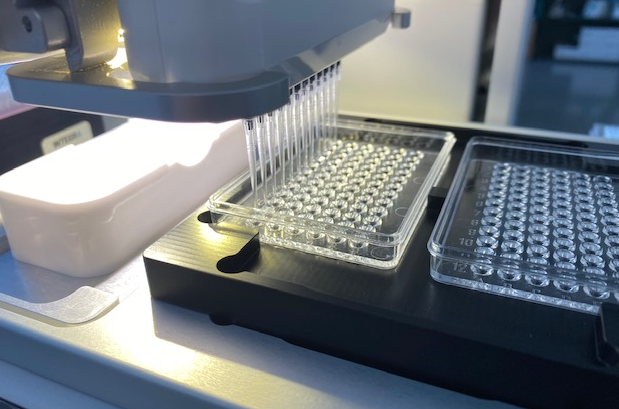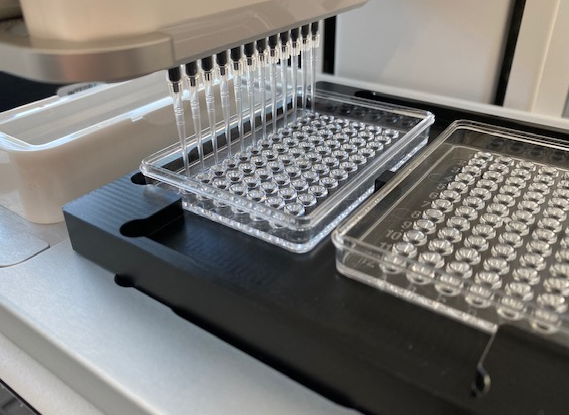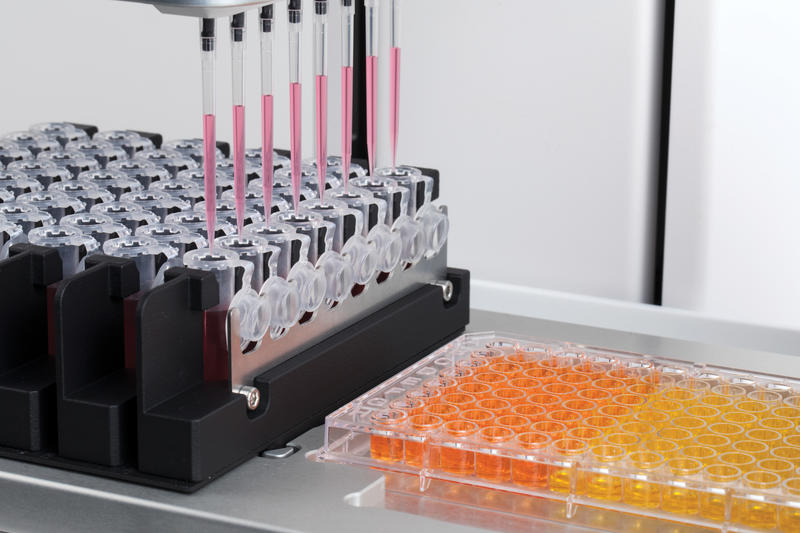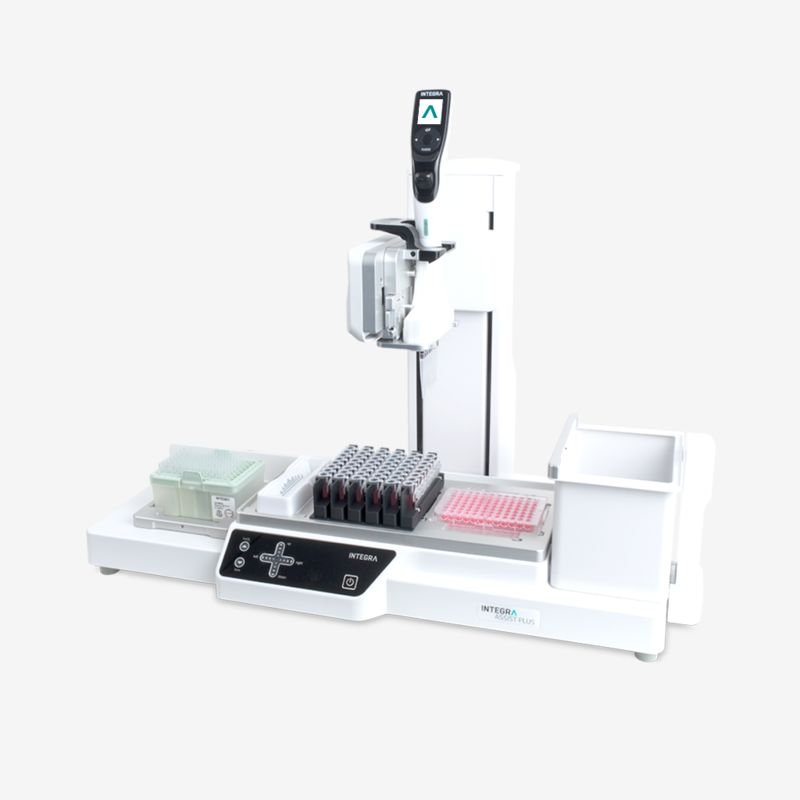Automate your HLA typing workflow with the ASSIST PLUS pipetting robot
There are a number of different HLA typing methods in use, and this article will discuss these methods, and how the ASSIST PLUS pipetting robot can automate multichannel pipetting to improve accuracy and reproducibility of the results, and free up time for lab personnel.
Serological HLA typing in a Terasaki tray
In HLA serotyping, antibodies are used to distinguish between the different variants of HLA antigens. A panel of HLA-specific antibodies is mixed with the donor serum to test if there is an immunological reaction, and to identify which HLA patterns are expressed by the cells. Prior to transplantation, serotyping with a final crossmatch allows screening for pre-existing antibodies to compare HLAs of the recipient and the donor. In this process, serum from the patient is mixed with lymphocytes of the donor.
In both applications a special plate – known as a Terasaki tray – is used. It contains 60 or 72 wells, with a capacity of about 10 µl per well, and mineral oil is used to prevent the evaporation of sample dispensed onto the tray. Pipetting these low volumes precisely into oil in the center of each well is tricky, and can cause difficulties even for the most experienced lab technician. The VOYAGER adjustable tip spacing pipette can be used with the ASSIST PLUS to automate this process, despite the unique dimensions of Terasaki trays. Automation ensures exact positioning of the pipette tip every time, enabling precise and accurate dispensing of small volumes with a consistent immersion depth and speed. To maximize efficiency, INTEGRA offers a specially designed adapter for this application, allowing users to process up to two Terasaki plates in a row for increased throughput and walkaway time.

ELISA-based and Luminex® HLA typing
Serotyping can also be performed as an ELISA to determine the reactivity between donor HLAs and recipient antibodies. In comparison to standard ELISAs, Luminex technology is a bead-based immunoassay system that allows detection of up to 100 analytes simultaneously, offering a higher sensitivity and specificity for HLA testing. It has therefore become the clinical standard for identification of donor specific HLA specific antibodies in solid organ transplantation worldwide.
ELISAs and Luminex assays are multi-well microplate-based assays – typically performed in 96 well plates – which can be efficiently processed with VIAFLO electronic multichannel pipettes. By clicking the pipette into the ASSIST PLUS, the ELISA steps can be automated, freeing up precious time in busy clinical labs and minimizing the inter-operator variability of the results. All tedious pipetting steps of the immunoassay – coating the plate, transferring samples, adding detection antibody, and stopping the reaction – can be easily automated by the ASSIST PLUS pipetting robot. An application note describing this in detail can be found here.

Molecular HLA typing
Clinical molecular typing strategies were developed when it became apparent that there were HLA variants which couldn't be distinguished serologically, but only by looking at the underlying genes. There are a number of sequence-based HLA typing protocols in use, including PCR sequence-specific primer (PCR-SSP), PCR sequence-specific oligonucleotide probe (PCR-SSOP), PCR sequence-based typing (PCR-SBT) and next generation sequencing (NGS). All molecular HLA typing methods begin with isolating nucleic acids from the sample, then using PCR to amplify the target region of interest, either the complete HLA region, full-length genes, or certain HLA exons. As the HLA system is a large gene complex spanning 3,600 kilobases, multiple PCR reactions are needed to allow typing of one sample.
INTEGRA offers an optimal system for nucleic acid extraction of samples using the ASSIST PLUS pipetting robot, and can also automate PCR set-up for molecular HLA typing, significantly reducing hands-on time and lowering the overall cost per sample. Efficient typing of high numbers of samples can be achieved, as even PCR set-up in 384 well plates can be easily automated. By automating the VOYAGER adjustable tip spacing pipette with the ASSIST PLUS, samples which are stored in tubes can be added to plates using multiple channels in parallel, guaranteeing accurate and precise handling of low volumes. Moreover, combining this set-up with INTEGRA's multichannel reagent reservoirs minimizes consumption of costly reagents, as the reservoir’s SureFlo™ anti-sealing array offers the lowest dead volume available on the market. If required, users can ensure samples remain cool during assay preparation by using adapters for reservoir and 96 well or 384 well PCR plate cooling.

For SBT and NGS methods, quantification and purification of the amplicons must be carried out after the PCR step, typically by magnetic bead purification. The flexible deck set-up of the ASSIST PLUS allows users to accommodate magnetic plates in order to automate tedious pipetting steps during the purification. Sample recovery is maximized by optimal pipetting settings, including tip immersion depth, pipetting speeds and tip angle. This ensures consistent positioning of the tip in the sample well to minimize the risk of disturbing the beads or bead carryover, providing high sample yields and purities for downstream sequence analysis.
Conclusions
Human errors or inaccurate liquid handling during HLA typing could lead to serious consequences if patients and donors do not match. Automating the workflow can minimize these risks. Using the ASSIST PLUS pipetting robot means that low volumes are pipetted with higher accuracy and precision compared to a manual workflow, which is particularly important in situations where samples can be small and precious. By combining the ASSIST PLUS with one of INTEGRA's 25 electronic multichannel pipettes – offering a variety volumes and number of pipetting channels – you are not restricted to only one HLA typing method, and can easily switch between different process and applications as your workflow demands. By automating the VOYAGER adjustable tip spacing pipette on the ASSIST PLUS, even Terasaki trays or tube racks can be processed, increasing productivity. This makes the ASSIST PLUS a versatile tool for diagnostics labs and transfusion and transplant centers wishing to enhance their HLA typing capabilities.
























